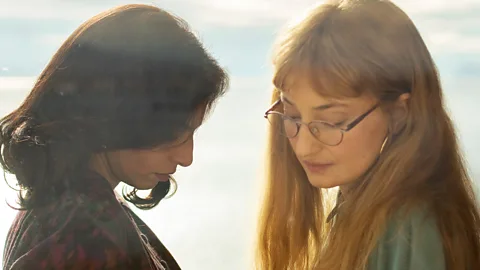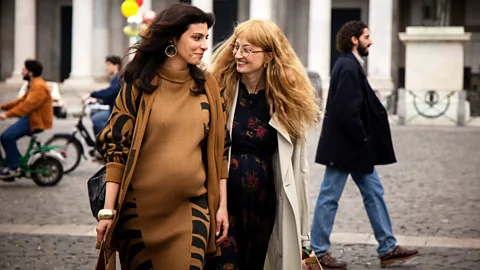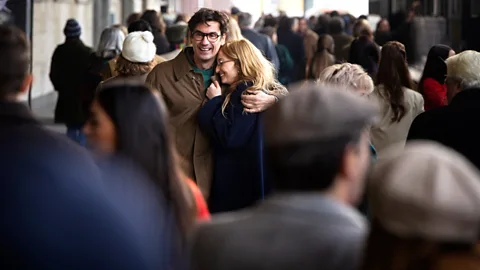 HBO
HBOAs the final season of the HBO adaptation of Elena Ferrante’s Neapolitan novels begins this week, why has the show not received the plaudits – and the viewership – it deserves?
Few novels have inspired as much devotion in recent years as those of the Italian writer, Elena Ferrante – specifically, the author’s Neapolitan quartet, which follows the lives of two childhood friends across six decades and four books, turning the intimate into an epic.
Originally published between 2011 and 2015, the four books sparked “Ferrante fever”, with millions of readers all over the world falling under the spell of Elena (also known as Lenù) and her “dazzling, terrible” friend Lila. Ferrante – whose identity famously remains a mystery – tackles themes of friendship, desire, motherhood, misogyny, ambition, class and violence, all in unsparing detail, and against the backdrop of a changing Italy. This summer, the first book in the series, My Brilliant Friend, was voted the best book of the 21st Century in a poll by The New York Times, which described it as an “uncompromising, unforgettable novel”.
By comparison, the TV adaptation of My Brilliant Friend has flown slightly under the radar. The show, which first aired in 2018 and starts its fourth and final season this week, hasn’t attracted the same column inches as other HBO dramas (the network co-produce the series with Italian broadcaster Rai), despite its much-loved source material, cinematic production values and epic scope. It has not swept awards shows, and is often missing from round-ups of the best prestige television (it failed to make the cut of BBC Culture’s own greatest TV series of the 21st Century poll in 2021).
 HBO
HBOYet, much as those who love Ferrante’s books do so feverishly, the show has amassed an equally devout army of fans. “Why is it not widely acknowledged to be the best show on TV?” asked author and journalist Taffy Brodesser-Akner on X recently, echoing the sentiments of many who believe it to be criminally underrated. It brings Ferrante’s world to life brilliantly and is as complex, gripping and immersive as the novels, while also being one of the best-looking series on television.
When the news first broke that there was to be a TV adaptation of Ferrante’s Neapolitan novels, expectations were high – but so was trepidation. Here were books loved for their interiority, their emotional nuance, for how deeply they explored complicated feelings. Language is integral to the books: when the two young girls secure a copy of Louisa May Alcott’s Little Women early in the first novel, it sparks a realisation that education and books could be a way out for them. How would a story so deeply attached to the power of the written word translate to the television?
Series creator Saverio Costanzo, who directed the first two seasons and remains co-writer and executive producer on the rest, knew all too well how difficult it was to bring beloved books to the screen. His 2010 film The Solitude of Prime Numbers was based on a novel by Paolo Giordano, which won Italy’s prestigious Strega Prize. “It wasn’t very successful because my point of view of the book was different to the majority of the readers of the book,” he tells the BBC. “So I promised myself not to adapt another bestseller.”
Coincidentally, a few years before that, he had attempted to adapt Ferrante’s novel The Lost Daughter. Ferrante granted him the rights temporarily, giving him six months to try and produce a script – but Costanzo couldn’t find a way to make the story, which is told partly in flashbacks, work (Maggie Gyllenhaal would later go on to turn the book into a film starring Olivia Colman).
Years later, out of the blue, Costanzo was in his kitchen when he got a call from Ferrante’s publishers about a new project: turning My Brilliant Friend and the rest of her Neapolitan novels into a television series. Despite his reservations about working with well-known source material, it was too good an opportunity to turn down. “I reread the books from the beginning and I felt so much into them,” he says. “I felt as a reader the same as so many readers around the world.”
Like many, Costanzo connected to how deeply Ferrante explored friendship, refusing to sentimentalise it, but showing how complicated, competitive and even cruel those bonds can be – and how much they shape our lives. “Friendship is the most free relationship that we experience in our life,” says Costanzo. “It’s a relationship made out of nothing, just will. It’s pure and yet also dangerous. To carry on a friendship for a lifetime is a full-time job, because you have to deal with your weakest parts, with envy, with love, but also with hate. There are no rules in friendship.”
 HBO
HBOWith the friendship between Elena “Lenù” Greco, the books’ narrator, and Raffaella “Lila” Cerullo, the beating heart of the story, finding the right actresses for the roles was vital. The audition process was lengthy, with Costanzo and his team seeing over 9000 potentials over eight months.
“The characters were so clear in Ferrante’s writing, that you couldn’t miss them,” says Costanzo. “Once I was looking for them, I was like, I know if I meet Lila or Elena, I will recognise them.”
He found them in Elisa Del Genio and Ludovica Nasti, who played the girls as young children, then in Margherita Mazzucco and Gaia Girace, who took over after two episodes. Mazzucco and Girace stayed until the end of season three, playing the women into their 30s, despite still being teenagers themselves.
In this new season, new faces step into the roles – Alba Rohrwacher (sister of film director Alice Rohrwacher – who directed two episodes in season two) as Elena, and Irene Maiorino (previously in Gomorrah) as Lila. Maiorino bears a striking resemblance to her predecessor Girace. Rohrwacher less so to Mazzucco – but viewers will certainly recognise her voice, as she has been the narrator of the show since the start. Besides the two women, the series has a gigantic cast of supporting characters. Many of these have also been recast throughout the seasons – but physical similarities weren’t the guiding factor. “Sometimes we were lucky,” says Costanzo. “Sometimes we went just for the soul of the character.”
The personal is the political
Just as crucial as the casting was bringing to life the Naples neighbourhood in which the girls grow up. “The neighbourhood is a character as much as Elena and Lila,” says Costanzo. “We wanted to show through the evolution of it the way Italy has changed.”
It’s widely believed Ferrante based the neighbourhood in her book on the real-life area of Rione Luzzatti, a working-class district to the east of the city centre that has now become an unlikely tourist spot, thanks to Ferrante fans. In the show, the neighbourhood is an elaborately constructed set – one of the biggest ever created in Europe. Built on the site of an abandoned glass factory, 45 minutes outside of Naples, it covers 215,000 sq ft (19,974 sq m) and, just as it would have in real life, it has changed throughout the seasons. In the first, it feels claustrophobic, grey and insular. When Elena and Lila are children, it is their entire universe, so much so that they don’t even see the sea until they are older. “In the 1950s it was a disconnected neighbourhood outside of the city,” says Costanzo. “And then slowly people start to build and the city becomes closer and closer to the neighbourhood.”
 HBO
HBOIt’s a neighbourhood marked by poverty, violence and organised crime (this isn’t a story explicitly about the Mafia, but their presence is often felt). As the women get older, their world gradually opens up – though for one more than the other – but the neighbourhood continues to shape their lives.
In My Brilliant Friend, the personal is the political, and the trajectory of the girls’ lives is entwined with that of Italy as a nation. Events such as the economic boom and student protests of the 1960s, the bloody battle between the communist and fascist movements, radical feminism, the legalisation of divorce, and – in the new season – widespread government corruption, all feed into Lenù and Lila’s experiences. “The political background behind the story of Lila and Elena, it is the real engine,” says Costanzo.
My Brilliant Friend was the first foreign-language series to ever premiere on HBO. The show isn’t just in Italian – there are large chunks in Neapolitan dialect, meaning even viewers in Italy need subtitles. The intricacies of speech are important. Neapolitan is the language of the neighbourhood, while Italian represents a life beyond it. Of course, these subtle shifts will be lost on many viewers, especially outside of Italy, but a refusal to round off the edges of Ferrante’s story is what has made this adaptation so successful. “Never, not even in a moment, have I used any kind of trick to make things easier for viewers,” says Costanzo.
Ferrante worked with Costanzo on the script, communicating only over email. He has previously described the process as like “working with a ghost”. But while she gave feedback and notes, she also gave him the freedom to pursue his vision for the show – something he’s passed on to the other directors who’ve taken up the mantle from him – Daniele Luchetti in season three and now Laura Bispuri in season four. “I told them, do your job, do your point of view,” says Costanzo. “I want them to feel as free as I was.”
This final season – based on Ferrante’s fourth book, The Story of the Lost Child – sees things come full circle, with Lenù and Lila brought back together in Naples after years apart. It’s now the 1980s, and decades of political and social unrest are coming to a close, but not before a succession of events again throw the women’s lives and friendship into turmoil once more.
For those enthralled with My Brilliant Friend, it will be difficult to say goodbye to these characters. Its creators feel the same, too. “I loved this project so much that I was ready to give 10 years of my life,” says Costanzo. Meanwhile, anyone who is yet to discover this spellbinding show has something very special waiting for them.
Season four of My Brilliant Friend is available on HBO now.

